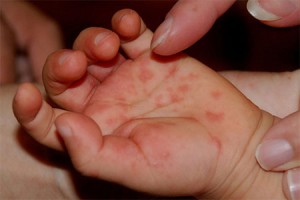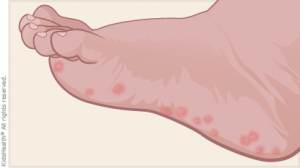Tis the Season for Hand, Foot, and Mouth Disease!
September 26, 2014
- 1.2K
- 1.2Kshares
Fah la la la laaaa la la la laaaaa! (Said no parent ever.)
In the past few weeks, almost every child I have seen come in the office with a rash has had Hand, Foot, and Mouth Disease. Every time I diagnose a child with something that has the word “disease” in it, parents usually shudder and give me a grimaced, fearful expression concluded with a deep sigh. But not to worry! Summer and early fall months tend to be the season for community outbreaks of this rather uncomfortable, but typically harmless condition. I have recently seen dozens of poor, speckled kids. So, since many children will have Hand, Foot, and Mouth Disease at one point or another; what is it and what should a parent do?
 Hand, Foot, and Mouth Disease is caused by viruses in the enterovirus family, most commonly coxsackievirus (Note: Hand, Foot, and Mouth Disease is not the same thing as Foot and Mouth Disease. I know that’s confusing, but Foot and Mouth Disease effects livestock. Even if your children sometimes act like livestock, I am happy to say that they will not get Foot and Mouth Disease!). Children age 1-4 are at highest risk for getting Hand, Foot, and Mouth Disease and it affects both boys and girls equally. This virus lives in the digestive tract and most children get it from unwashed hands or surfaces contaminated from feces (I know, gross). Here is what a typical presentation looks like:
Hand, Foot, and Mouth Disease is caused by viruses in the enterovirus family, most commonly coxsackievirus (Note: Hand, Foot, and Mouth Disease is not the same thing as Foot and Mouth Disease. I know that’s confusing, but Foot and Mouth Disease effects livestock. Even if your children sometimes act like livestock, I am happy to say that they will not get Foot and Mouth Disease!). Children age 1-4 are at highest risk for getting Hand, Foot, and Mouth Disease and it affects both boys and girls equally. This virus lives in the digestive tract and most children get it from unwashed hands or surfaces contaminated from feces (I know, gross). Here is what a typical presentation looks like:
All of a sudden, your little sweetheart feels warm. You take her temperature and she has a 101°F fever. This fever lasts for about a day or two. (If you want to learn how to give the best care to your feverish child, I really recommend you download my short ebook, “Don’t Sweat It: Fever Facts Every Parent Should Know”right now. I promise it will totally change your  mindset about fevers and empower you as a parent!). The next morning she wakes up, and she doesn’t want to eat anything. Swallowing may look painful and older children will tell you that their throat is sore. If you look in the mouth, you will see red lesions that can appear on the tongue, gums, hard palate, or inside the cheeks. Shortly after that, you may notice small, red blisters or spots on your child, typically on the hands and feet – hence the incredibly clever disease name. I don’t know who had the honor of naming Hand, Foot, and Mouth Disease, but I always wonder why they didn’t go ahead and name it Hand, Foot, Mouth, and Bottom Disease, because children will often get some spots on that part of their body too and it will look just like a diaper rash. These symptoms tend to last for about 3-5 days. It’s important to note that children may get spots on all of the above locations or just some. It just depends on the case!
mindset about fevers and empower you as a parent!). The next morning she wakes up, and she doesn’t want to eat anything. Swallowing may look painful and older children will tell you that their throat is sore. If you look in the mouth, you will see red lesions that can appear on the tongue, gums, hard palate, or inside the cheeks. Shortly after that, you may notice small, red blisters or spots on your child, typically on the hands and feet – hence the incredibly clever disease name. I don’t know who had the honor of naming Hand, Foot, and Mouth Disease, but I always wonder why they didn’t go ahead and name it Hand, Foot, Mouth, and Bottom Disease, because children will often get some spots on that part of their body too and it will look just like a diaper rash. These symptoms tend to last for about 3-5 days. It’s important to note that children may get spots on all of the above locations or just some. It just depends on the case!
[fusion_builder_container hundred_percent=”yes” overflow=”visible”][fusion_builder_row][fusion_builder_column type=”1_1″ background_position=”left top” background_color=”” border_size=”” border_color=”” border_style=”solid” spacing=”yes” background_image=”” background_repeat=”no-repeat” padding=”” margin_top=”0px” margin_bottom=”0px” class=”” id=”” animation_type=”” animation_speed=”0.3″ animation_direction=”left” hide_on_mobile=”no” center_content=”no” min_height=”none”]

I love this graphic from www.kidshealth.org!
Treatment for this disease is supportive. That means that the goal is to keep your child comfortable while the immune system fights off this virus. There is no specific vaccine or medication for Hand, Foot, and Mouth Disease. If you are ever concerned about your child, consult their pediatric health provider.
The first most common question from parents: are the spots painful? Typically the spots that occur on the hands and feet are not painful. Some children complain of itchiness. If your child is itchy, I like using 1% Hydrocortisone ointment (available over-the-counter everywhere). However, the spots in the mouth develop into ulcers and can be painful to children. The top priority is keeping your child adequately hydrated. If you are ever concerned your child is dehydrated, go to your pediatric health provider immediately. Get creative at home with fluids! Cold drinks and popsicles keep little throats quite comfortable. Children’s Tylenol or ibuprofen can be used if your child is still uncomfortable. Remember, do not give any children aspirin.
The second most common question from parents: how long is my child contagious? Well, unfortunately, the virus can be found in the stool for weeks. Also, while some children have flat, red spots, others can develop fluid-filled blisters. The fluid in these blisters is contagious. Proper hand washing is so very, very important in combatting the spread of this virus! After your child is fever-free for at least 24 hours AND when all the blisters have scabbed over and are no longer fluid-filled, your child can return to normal activity.
I hope the next time Tis the Season comes up we are all enjoying hot chocolate by the Christmas tree, but until then, feel empowered to help your little one through Hand, Foot and Mouth Disease should it strike your family!
Here are some helpful links:
http://www.cdc.gov/hand-foot-mouth/
http://kidshealth.org/parent/infections/skin/hfm.html#
[/fusion_builder_column][/fusion_builder_row][/fusion_builder_container]
- 1.2K
- 1.2Kshares
Thank you for this article. I was trying to find when it’s okay to khedr my son back to daycare.